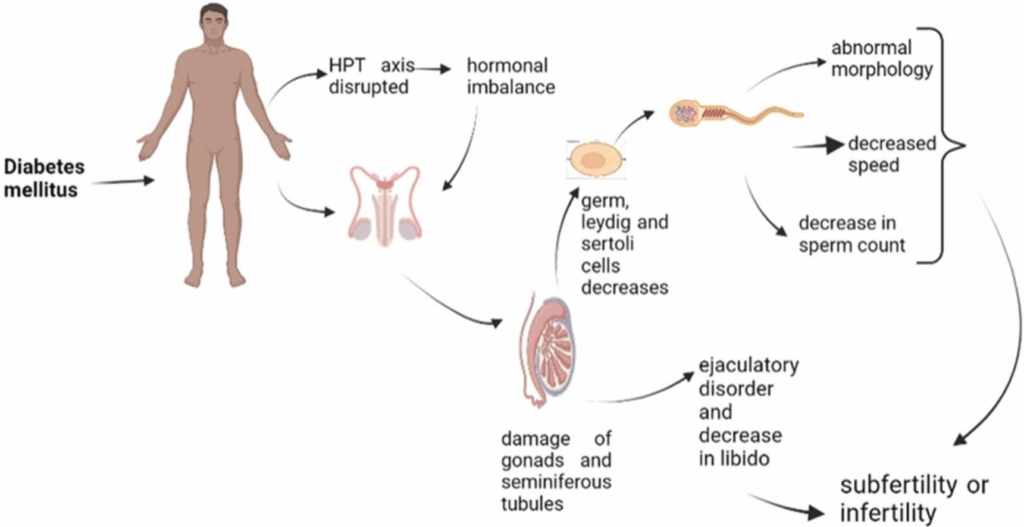Disorders of sex hormones refer to conditions that result from imbalances in the production, regulation, or action of sex hormones (estrogen, progesterone, and testosterone). These imbalances can affect sexual development, reproductive function, and secondary sexual characteristics.

Types of Disorders of sex hormones
1. Hypogonadism: Reduced function of the gonads (testes or ovaries), leading to decreased sex hormone production.
2. Polycystic Ovary Syndrome (PCOS): A common endocrine disorder in women characterized by irregular menstrual cycles, hyperandrogenism, and polycystic ovaries.
3. Androgen Insensitivity Syndrome (AIS): A condition where individuals with XY chromosomes have a partial or complete inability to respond to androgens.
4. Congenital Adrenal Hyperplasia (CAH): A group of genetic disorders affecting adrenal steroidogenesis, leading to overproduction or underproduction of sex steroids.
5. Turner Syndrome: A chromosomal disorder in females characterized by the absence of all or part of one X chromosome, leading to gonadal dysgenesis and estrogen deficiency.
6. Klinefelter Syndrome: A chromosomal disorder in males characterized by an extra X chromosome (47,XXY), leading to hypogonadism and testosterone deficiency.
Causes of Disorders of sex hormones
Hypogonadism: Genetic disorders, autoimmune diseases, infections, injuries, radiation, chemotherapy, or hormonal imbalances.
PCOS: Genetic predisposition, insulin resistance, and hormonal imbalances.
AIS: Mutations in the androgen receptor gene.
CAH: Mutations in genes encoding enzymes involved in adrenal steroidogenesis (e.g., 21-hydroxylase deficiency).
Turner Syndrome: Complete or partial monosomy of the X chromosome.
Klinefelter Syndrome: Presence of an additional X chromosome (47,XXY).
Pathophysiology of Disorders of sex hormones
Hypogonadism:
Primary Hypogonadism: Failure of the gonads to produce sex hormones due to direct damage or dysfunction.
Secondary Hypogonadism: Dysfunction in the hypothalamus or pituitary gland, leading to insufficient gonadotropin release (LH and FSH), which in turn affects sex hormone production.
PCOS:
Hyperandrogenism: Excessive androgen production by the ovaries or adrenal glands.
Insulin Resistance: Insulin resistance and hyperinsulinemia contribute to increased androgen production and anovulation.
Follicular Arrest: Disrupted follicle development in the ovaries, leading to cyst formation and irregular ovulation.
AIS:
Androgen Receptor Dysfunction: Mutations in the androgen receptor gene prevent normal androgen signaling, leading to feminization or ambiguous genitalia in individuals with XY chromosomes.
CAH:
Enzyme Deficiency: Deficiency in enzymes such as 21-hydroxylase leads to impaired cortisol and aldosterone synthesis, resulting in adrenal hyperplasia and excessive androgen production.
Turner Syndrome:
Gonadal Dysgenesis: The absence of one X chromosome leads to underdeveloped gonads (streak ovaries) and estrogen deficiency.
Klinefelter Syndrome:
Testicular Dysgenesis: The presence of an extra X chromosome affects testicular development and function, leading to reduced testosterone production and infertility.
Symptoms of Disorders of sex hormones
Hypogonadism:
– Delayed puberty
– Infertility
– Reduced libido
– Erectile dysfunction (in males)
– Amenorrhea (in females)
– Loss of secondary sexual characteristics
PCOS:
– Irregular menstrual cycles
– Hirsutism (excess body hair)
– Acne
– Weight gain
– Infertility
– Acanthosis nigricans (darkened skin patches)
AIS:
– Ambiguous genitalia or female external genitalia in individuals with XY chromosomes
– Lack of menstruation
– Breast development without significant body hair or acne
CAH:
– Virilization in females (e.g., clitoromegaly)
– Early puberty in both sexes
– Salt-wasting crisis in severe forms (21-hydroxylase deficiency)
Turner Syndrome:
– Short stature
– Webbed neck
– Broad chest with widely spaced nipples
– Lack of breast development and menstruation
– Infertility
Klinefelter Syndrome:
– Tall stature with long limbs
– Gynecomastia (breast development in males)
– Small testes
– Reduced facial and body hair
– Infertility
Treatment of Disorders of sex hormones
Hypogonadism:
Hormone Replacement Therapy: Testosterone replacement in males; estrogen and progesterone replacement in females.
Fertility Treatments: Assisted reproductive technologies (ART) for infertility.
PCOS:
Lifestyle Changes: Weight loss, diet, and exercise.
Medications: Oral contraceptives to regulate menstrual cycles, anti-androgens to reduce hirsutism, and insulin-sensitizing agents (e.g., metformin).
Fertility Treatments: Clomiphene citrate or gonadotropins to induce ovulation.
AIS:
Hormone Replacement Therapy: Estrogen replacement in individuals with complete AIS to induce and maintain female secondary sexual characteristics.
Surgical Management: Removal of undescended testes to prevent malignancy.
CAH:
Glucocorticoid Replacement: Hydrocortisone to replace deficient cortisol and suppress excessive androgen production.
Mineralocorticoid Replacement: Fludrocortisone for salt-wasting forms.
Surgery: Corrective surgery for genital abnormalities.
Turner Syndrome:
Growth Hormone Therapy: To increase height.
Estrogen Replacement Therapy: To induce and maintain secondary sexual characteristics and menstrual cycles.
Fertility Treatments: Use of donor eggs and assisted reproductive technologies.
Klinefelter Syndrome:
Testosterone Replacement Therapy: To develop and maintain secondary sexual characteristics.
Fertility Treatments: Testicular sperm extraction and intracytoplasmic sperm injection (ICSI) for assisted reproduction.
Psychological Support: Counseling for emotional and psychological well-being.
Management of sex hormone disorders involves a multidisciplinary approach, including endocrinologists, gynecologists, urologists, geneticists, and psychologists, to optimize patient outcomes and quality of life.
Visit: Pharmacareerinsider.com




